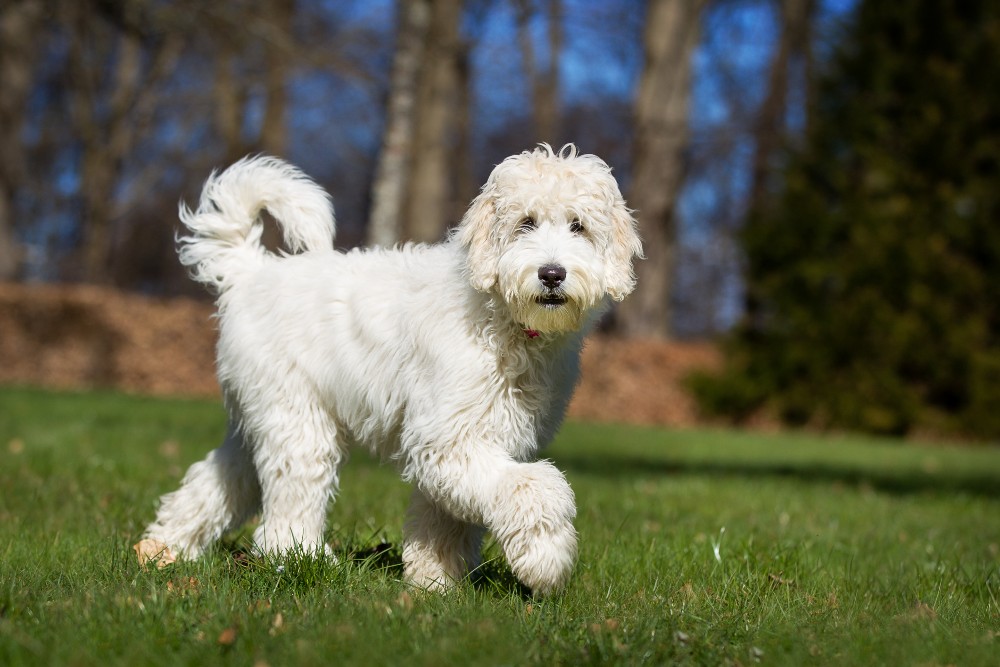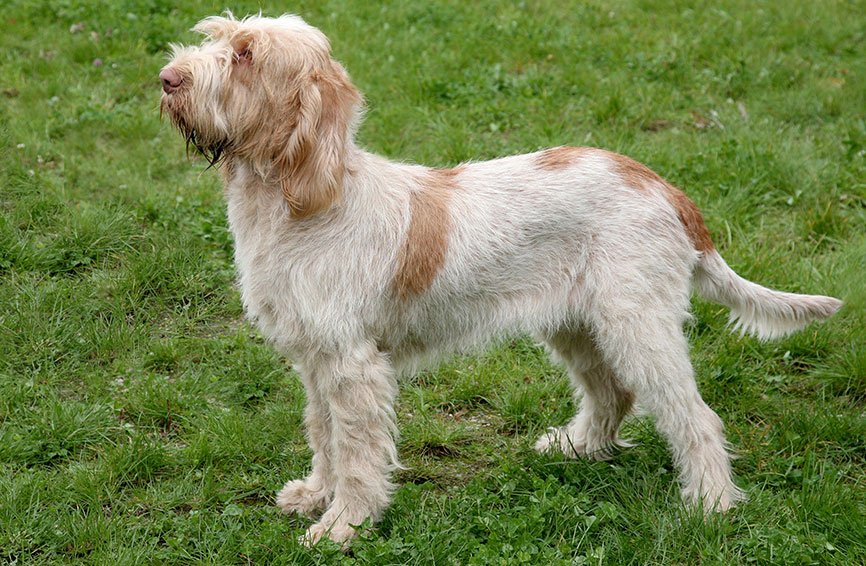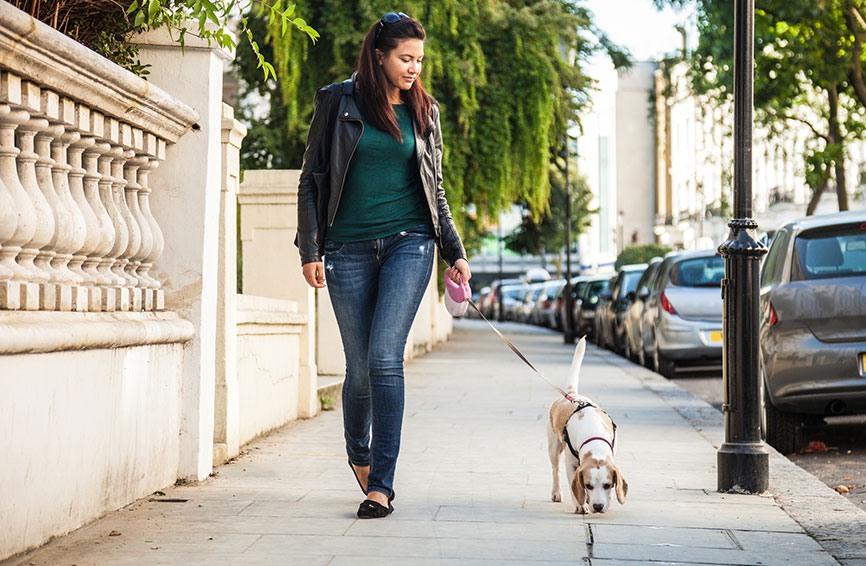Table of Contents
Introduction to Labradoodles
Just because the Labradoodle is not classified as an official breed by any major kennel club doesn’t mean that these dogs aren’t a great fit for your household. In fact, they are one of the most beloved types of dogs in the country!
Labradoodles are a type of crossbreed dog that is created by mixing a Labrador Retriever and a Poodle. These are lovable, smart, and social dogs that make wonderful pets and often have hypoallergenic qualities to accommodate sensitivities in your family.

Size of Labradoodles
The size of a Labradoodle depends on whether you mix a Labrador Retriever with a Standard, Medium, or Miniature Poodle. Therefore, the sizes of these dogs can vary greatly.
Here is what you can expect size-wise as your lovable Labradoodle grows from being a puppy to an adult.
| Weight Chart | 4 months | 8 months | 12 months |
|---|---|---|---|
| Miniature Labradoodles | 14.4 pounds | 24 pounds | 29 pounds |
| Medium Labradoodles | 19.9 pounds | 31.9 pounds | 34 pounds |
| Standard Labradoodles | 26.8 pounds | 49.2 pounds | 59.1 pounds |
In general, miniature and medium Labradoodles are typically full-grown by one year of age, while standard Labradoodles can take up to 16 months to reach their final adult size.
In terms of height, mini Labradoodles measure 13-17 inches tall at the shoulder, while medium Labradoodles stand 17-20 inches tall, and standard Labradoodles measure 20-26 inches tall when fully grown.
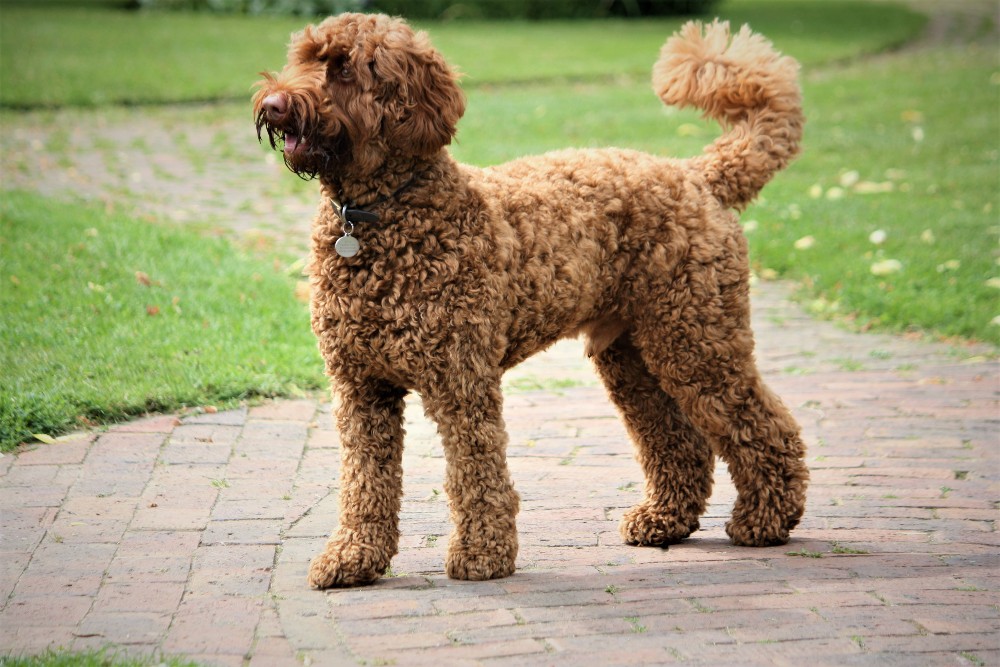
Characteristics of Labradoodles
Labradoodles have physical and behavioral traits from the Labrador and the Poodle, which makes them desirable family pets. As you get to know a Labradoodle’s personality, here’s what you can expect based on his or her breed characteristics.
| Breed Characteristic | Level (High, Medium, Low) |
|---|---|
| Affectionate with People | High |
| Good with Kids | High |
| Good with Pets | High |
| Need for Exercise | High |
| Energy Level | High |
| Intelligence Level | High |
| Able to Be Trained | High |
| Amount of Barking | Low |
| Amount of Shedding | Medium |
Labradoodles are known for being family-friendly dogs that are very affectionate. They are also loyal and trainable, which makes them good candidates for working or therapy dogs. They are good around kids and other dogs, but they have high energy levels, which means they need frequent exercise and attention. Labradoodles aren’t necessarily good guard dogs they but might bark if an intruder is around your home.
As a mixed breed, Labradoodles’ personalities may vary quite a bit from one to the next. Some of these pups are more like Labrador Retrievers, while others are more like Poodles. This means that your Labradoodle might have different personality traits than other Labradoodles that live with your friends or family members.

History of Labradoodles
A Labradoodle is a relatively new type of dog. While the term was first used in the mid-1950s, it was not universally recognized until the late 1980s. An Australian named Wally Conron is credited as the modern creator of the Labradoodle because he bred a Labrador Retriever and a Standard Poodle with the goal of creating a hypoallergenic guide dog. He introduced this crossbreed to the Royal Guide Dog Association of Australia and it became increasingly popular from then on.
Labradoodles are considered to be “designer dogs” and have become very popular in the U.S. in recent decades. Conron has said that he regrets creating the Labradoodle because the high demand for these dogs has led to irresponsible breeding. Misguided breeders often fail to consider genetic issues in their dogs, which causes birth defects and health issues in new generations of Labradoodles.
Labradoodle Standard Information
The Labradoodle is not yet recognized as an official breed of dog, so there is no official standard information for this crossbreed currently. However, the Australian Labradoodle Association, Labradoodle Association of America, and the International Australian Labradoodle Association are working to create widely accepted breed standards and unite breeders with responsible breeding practices.
Courtesy of the Worldwide Australian Labradoodle Association, here is an overview of standard information for the Labradoodle.
Head:
- Moderately broad head with wide-set eyes
- Slightly rounded skull
- Scissor bite with upper teeth overlapping bottom
- Large, round, and expressive eyes
- Ears lay flat against head
Neck, Topline, Body:
- Strong, well-proportioned neck
- Shoulders laid back
- Level topline that’s square and compact
- Long tail that’s not too thin

Forequarters and Hindquarters:
- Forelegs straight from the front
- Muscular hindquarters
- Rounded feet with arched toes
- Buttocks nearly flat
Coat:
- Can have a straight coat or loose curls
- Coat can resemble hair, wool, or fleece
- Non-shedding or low-shedding
Color:
- Various colors from light cream to dark black
Gait:
- Powerful and well-coordinated gait
- Good reach in front and drive from the back
Caring for Labradoodles
Labradoodles are generally easy to care for and fun to spend time with. However, these dogs need a good amount of space to run around and play in to be mentally stimulated and physically fit. They also require regular grooming.
Here are some general tips for taking the best care of a Labradoodle.
Best Living Environments:
- Houses with large yards to run around in
- Not ideal for apartments or small enclosed spaces
- Great in rural and suburban settings
- Households with other pets and kids
- Fine for first-time dog owners
- Should live inside a house, not outdoors full-time
Types of Exercise:
- Needs about 30-60 minutes of exercise per day
- Long runs with owners
- Off-leash play in dog parks
- Swimming in pools or lakes
Mental Enrichment:
- Needs to be physically and mentally stimulated or can become destructive
- Eager to please family members and motivated by food
Training Strategies:
- Socialize from puppyhood to prevent aggression
- Enroll in a training class by at least 10-12 weeks old
- Crate train to prevent accidents and destruction
Grooming Tips:
- Brush coat twice per week
- Ear cleaning once a week
- Clip nails twice a month
- Bathe once monthly
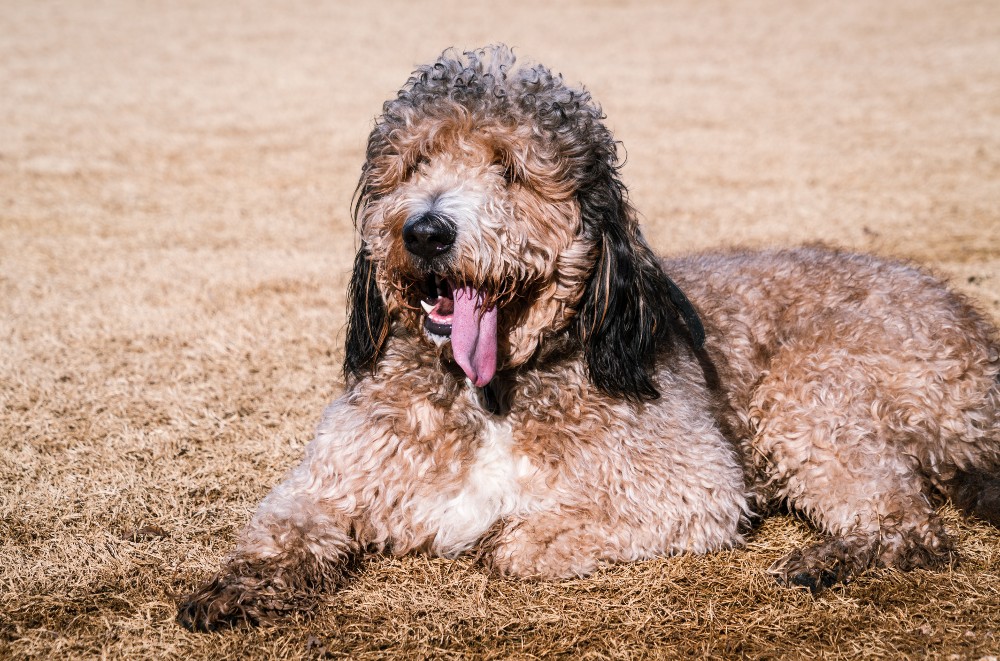
Common Health Problems of Labradoodles
Fortunately, Labradoodles are typically healthy dogs that are resilient and live long lives. However, there are certain medical conditions to which they are genetically predisposed, or that occur due to environmental factors. These are some of the most common health issues that arise in Labradoodles.
- Hip dysplasia due to Labrador genetics
- Elbow dysplasia due to rapid growth rates
- Ear infections due to floppy ears and allergies
- Progressive retinal atrophy due to genetics
- Skin sensitivities due to environmental or food allergies
- Addison’s disease due to Poodle genetics
- Epilepsy due to genetics
Something beneficial about mixed breed dogs is the increased genetic diversity which greatly reduces the risk of these health conditions. However, it’s important to know that Labradoodles are still susceptible to the genetic conditions of both parent breeds, the Labrador Retriever and the Poodle.
The average lifespan of a Labradoodle is 10-15 years. Yearly vet checkups and preventative care are incredibly important to ensure your Labradoodle stays healthy during his or her lifetime. Your veterinarian can check for any signs of underlying joint problems (which are easier to correct at an early age) as well as discuss proper care of this crossbreed at these visits.
Diet and Nutrition for Labradoodles
To fuel the high-energy lifestyle of a Labradoodle, feed your dog a high-quality, balanced dog food. The amount of food your dog needs depends on the level of activity, age, metabolism, and size. In addition, each dog food is formulated differently, and the feeding guidelines on the label are a great reference. Puppies should be fed a diet specifically for the growth stage until they are one year old, at which point it is appropriate to switch to an adult kibble. Around seven years of age, it is recommended to transition to a senior dog food to better meet the nutritional needs of this age group.
Splitting your labradoodle’s meals into two to three smaller portions per day will help him or her feel full longer and reduce the risk of bloat. Recommended brands include Science Diet, Purina, and Royal Canin. It is not uncommon for a Labradoodle to be a picky eater. Labradoodles also have a tendency to overeat, so you’ll need to keep an eye on your dog’s diet.
Where to Adopt or Purchase Labradoodles
Unfortunately, puppy mills are becoming commonplace for Labradoodles which can introduce health issues into the lineage. Therefore, it is best to purchase a Labradoodle from a reputable breeder, especially one that practices multi-generational breeding. Labradoodles can be quite costly to purchase from a breeder, so it is important to do your research beforehand.
You can also find Labradoodles available for adoption from shelters and nonprofit organizations. If you can’t find a Labradoodle-specific rescue group in your area, consider contacting a Labrador Retriever or Poodle rescue because they often care for mixed breeds as well as pure breeds. Petfinder.com is another good resource for finding a Labradoodle near you.
Related Breeds
If Labradoodles have sparked your interest, you might be curious to learn about other similar breeds of dogs as well. Here are some related breeds to check out.
- Labrador Retriever
- Standard Poodle
- Miniature Poodle
- Goldendoodle (Golden Retrievers + Poodles)
- Schnoodles (Schnauzers + Poodles)
- Shepadoodles (German Shepherds + Poodles)
- Whoodles (Wheaten Terriers + Poodles)
Pet Insurance for Labradoodles
Since you can’t always know what will happen in the future, it’s best to be prepared for whatever comes your dog’s way. One of the best things you can do to invest in your dog’s current and future health is to get pet insurance from Healthy Paws. With no maximum annual or lifetime payouts and most claims processed within two days, it’s never been easier to protect your Labradoodle from accidents, injuries, and illnesses.
Check out our website to compare plans and find the right one for you and your pup. The plan covers everything from emergency care to genetic conditions, alternative care, and more so that you can live your very best life with your beloved Labradoodle by your side.
